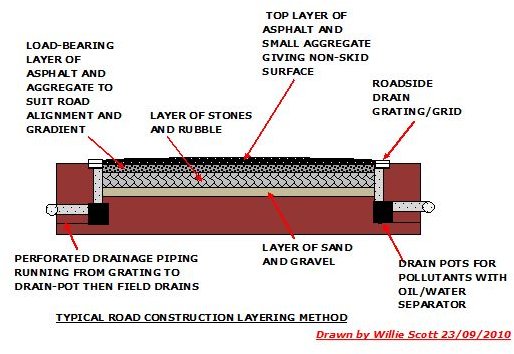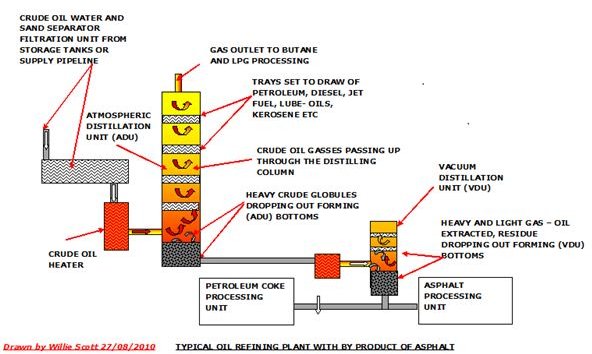When was Asphalt Invented?
Introduction: Who Invented Asphalt?
Asphalt can be found in various locations throughout the world as a natural occurring substance, or as a by-product of crude oil refining. It has been used for several centuries as a waterproofing agent and a component in road building and surfacing.
This is an article on asphalt where we will look at the origins of natural and refined petroleum asphalt. We begin with the extraction of asphalt from the process of oil refining.
Asphalt Processed from Crude Oil Refining
At an oil refinery, crude oil is filtered to remove any salts and sand. It is then heated and fed into an Atmospheric Distillation Unit (ADU) where the various fractions of petroleum, diesel, kerosene, and lube-oils and are extracted. This leaves the thick tarry substance known as ADU bottoms, some of which can be used heavy fuel oil for marine diesel engines and power plants.
The remainder of these bottoms are reheated and passed through a Vacuum Distillation Unit, from which light and heavy gas oil is extracted leaving VDU bottoms. These are processed into petroleum coke and asphalt.
Overview of Natural Asphalt History
Asphalt also known as bitumen is a natural occurring substance being found in oil bearing rocks in the Athabasca Oil Sands in Alberta, Canada and various pitch lakes in Trinidad and Venezuela.
It has been used since biblical times as a waterproof coating and a lamp oil for illumination.
Sir Walter Raleigh discovered asphalt on the island of Trinidad in 1595 where the locals traded this to him to waterproof the wooden hulls of the ships against worms and water ingress.
It was about this era that asphalt was introduced to the USA, however it was not until almost 200 years later that natural asphalt from Trinidad was used in the construction of Pennsylvania Avenue in Washington, DC.
Reference Webs:
1. planetware - pitch lake natural asphalt.
2. curbstone - first natural asphalt used in road construction.
Asphalt from Oil Refining for Roadbuilding
In the early 1900’s, oil companies such as Sun-oil, Gulf-oil, and Texas Refining were involved in the refining of crude oil to petroleum just as the newly invented internal combustion engine was used in the first aeroplane flight by the Wright Brothers.
The Rockefeller Standard Oil Company Cartel was dissolved by the government and new companies sprung up, many still in existence today, including Mobil, ESSO, Chevron, Exxon and Amoco.
Asphalt processed from crude and known as refined petroleum asphalt was now being exploited and used in resurfacing the roads and parking lots.
The reasons for switching from natural asphalt to the refined petroleum asphalt were processing and haulage costs. Refined asphalt gave a much superior quality of asphalt, and later on processing of asphalt to meet different road conditions was required. This was carried out on the refined petroleum asphalt, normally at the refineries.
In 1912 there were 900,000 automobiles on the road and by 1920 this had jumped to 7.5 million, now the automobile was driving the progress of road building and in particular highways, along with the relative standards of construction.
Referenced Webs:
1. wrbailey - history of road surfacing.
2. macadam - first asphalt road in USA.
3. railsaandtrails - history of autos USA.
Road Construction – Modern Methods
These roads were based on several prominent Scottish engineers’ designs with Macadam being the most popular choice.
As automobiles became more popular, the increase led to more new roads and highways being built to carry them and experience in road construction grew at a fierce rate to meet this new challenge.
The use of the refined petroleum asphalt was the norm and engineers could dictate the composition of asphalt required to meet the needs of the road surfaces such as traffic speed and volume, which varied throughout the country.
A typical method is noted below:
- 1st Layer.
The surface of the excavated area is compacted and levelled. Fine sand and gravel mix is laid on top of this at a predetermined depth and compacted until no further indentations can be made. This layer acts as a vegetation inhibitor and drainage medium, drainage being one of the most important qualities in road construction.
- 2nd Layer
This consists of a layer of stones and rubble, sieved to a required size and compacted using mechanized heavy roller equipment.
- 3rd layer
This is the load-bearing layer and is made up from a mix of hot asphalt mixed with a aggregate of uniform sized stone chips, once again the size being dictated by the road conditions.
This is then rolled flat using heavy roller equipment.
- 4th Layer (Final Surface)
The surface layer is known as Stone Mastic Asphalt. It is made up from different grades of small aggregate that have been previously coated in hot bitumen that acts as a binder when mixed thoroughly with hot asphalt.
The mix is then laid using a specialist machine that ensures an even spreading to the requisite thickness, leaving a slight camber from the center of the road to the edges.
Water drain gratings are inserted at the edge of the road connected to underground pots. These pots act as oily water separators, from which the water is fed to perforated drain pipes to field and ditch drains.
The pots are emptied regularly using tanker trucks with suction equipment.
Referenced Webs:
1. macadam - early roadbuilding.
2. htma- properties of road surfaces.
3. docrep - road construction.
Sketches of Road Construction and Asphalt from Crude Refining

